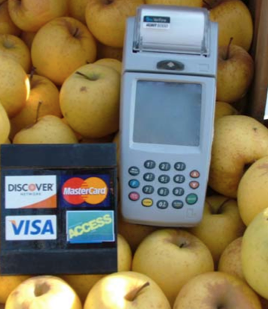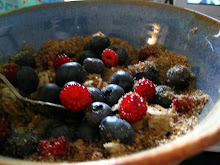 Ambercup Squash. Is what this is called, as I understand it.
Ambercup Squash. Is what this is called, as I understand it.So that no one else falls prey to not knowing about the Ambercup Squash (or pumpkin-like squash, as I've come to call it), here is a little guide to squash, which I found helpful. If you scroll down and look on the right, you'll see a picture of the little darling you see here to the left.
What we've done with it is we've cut it in two, with a puny little knife, which is what we have right now, so it looks a little hacked, but that shows the texture off better in a later picture, so that's OK. Cut it with a big, sharp knife if you have one (don't hurt yourself, for crying out loud), because it was really hard cutting it with the little one. Anyway. You don't put the apples in right away.
 Just set those apples aside for now. You're going to fill the bowl of the squash with a little olive oil, molasses, and cinnamon (brown sugar, if you have that, I'm delaying going to the grocery store, so I am currently out).
Just set those apples aside for now. You're going to fill the bowl of the squash with a little olive oil, molasses, and cinnamon (brown sugar, if you have that, I'm delaying going to the grocery store, so I am currently out).
 Cover each half with aluminum foil and bake at 350 for about half an hour. Then you're going to take it out, fill the bowls with the diced apples, drizzle with a bit more oil, molasses, sprinkle with whatever you like, whatever you have, cover it back up and bake for about another 30-40 minutes.
Cover each half with aluminum foil and bake at 350 for about half an hour. Then you're going to take it out, fill the bowls with the diced apples, drizzle with a bit more oil, molasses, sprinkle with whatever you like, whatever you have, cover it back up and bake for about another 30-40 minutes.
When a fork goes in smoothly and easily, it's done, eat it.
 You've probably noticed that I talk about molasses a lot. That's because a.) it's a smoky sweet acquired taste that I have soundly acquired and b.) two tablespoons of it contains 20% of my "recommended daily value" of iron, of calcium, and of vitamin A. I don't even know what vitamin A does, but I'll take it. I know what iron and calcium do, those are good, at least plant-sources of them are good.
You've probably noticed that I talk about molasses a lot. That's because a.) it's a smoky sweet acquired taste that I have soundly acquired and b.) two tablespoons of it contains 20% of my "recommended daily value" of iron, of calcium, and of vitamin A. I don't even know what vitamin A does, but I'll take it. I know what iron and calcium do, those are good, at least plant-sources of them are good.Keeping your bones strong depends more on preventing the loss of calcium from your body than on boosting your calcium intake.Use molasses liberally. (Progressively, even.)Some cultures consume few or no dairy products and typically ingest fewer than 500 milligrams of calcium per day. However, these people generally have low rates of osteoporosis. Many scientists believe that exercise and other factors have more to do with osteoporosis than calcium intake does.





























I think this recipe would work with the little pumpkins from our garden, too.
ReplyDelete